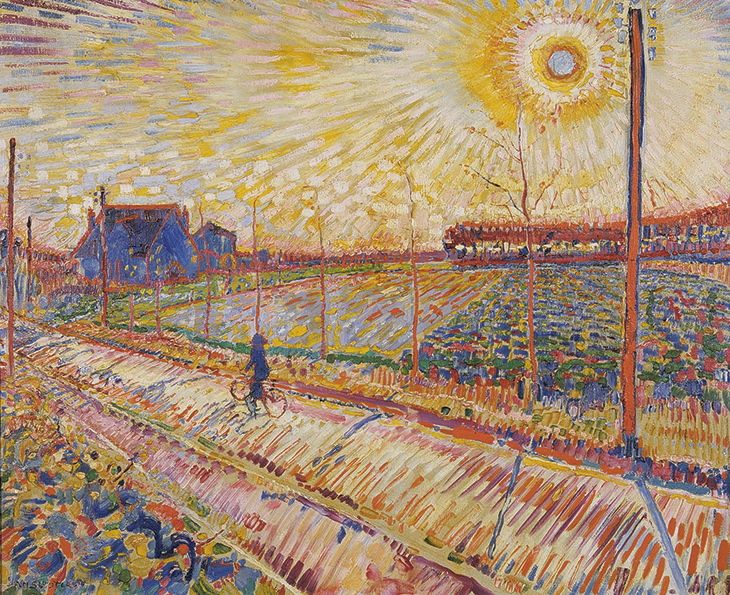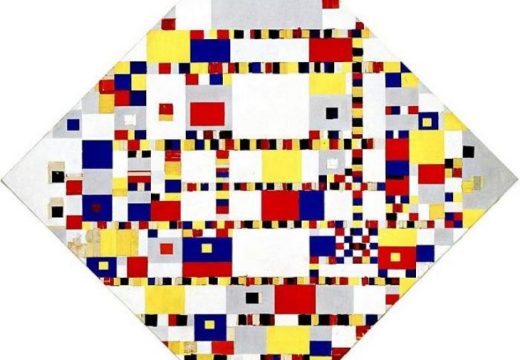It might at first seem unfortunate that the entrance to the exhibition ‘Jan Sluijters: De Wilde Jaren’ (‘The Wild Years’) at the Noordbrabants Museum should lie through rooms hung with works of its subject’s late career. Sluijters (in English often spelled ‘Sluyters’) died in 1957 at the age of 75. Between 1914 and that date, he worked in a variety of styles that were, and set out to be, the opposite of wild.
Unable to sell the more adventurous paintings of his youth, Sluijters, in his early thirties, did what many struggling artists do and turned his back on the avant-garde. For the last four decades of his life, he painted portraits of his wives and civic worthies, in a style that varied but was never more modern than a local clientele would allow. Many of these portraits are in the museum’s permanent collection, hanging in the rooms that lead to the exhibition reviewed here. Some are well-handled – De bokser Rolf (c. 1918), of a black prizefighter, is among the best – but fewer might have been given wall space had not Sluijters hailed from ’s-Hertogenbosch. Before visitors arrive at the entrance to ‘De Wilde Jaren’, therefore, they know how the artist’s story is going to end.

Kermesse à la Porte Maillot (1906), Jan Sluijters. Courtesy Pictoright Amsterdam 2018; © Jan Sluijters
That the exhibition should begin with this spoiler is far from a weakness, however. Sluijters, in either of its spellings, is not a name much known outside of the Netherlands. Part of the reason for this is that the painter, having travelled often to Paris from 1904, was prevented from doing so after 1914 by the onset of the First World War. Unlike his early friend and compatriot, Piet Mondrian, an adoptive Parisian likewise trapped at home by hostilities, Sluijters elected to stay on in Amsterdam once peace had been restored. Mondrian and Theo van Doesburg both made their names in Paris after 1918, even if their brainchild, De Stijl, had been born in Holland; so, earlier, had Sluijters’ fellow Brabanter, Vincent van Gogh. By remaining in Holland, Sluijters ensured that posterity would treat him less well than it did his expatriate fellows.

Dumping Carts (1907), Jan Sluijters. Photo: Studio Tramp, Rotterdam; courtesy Pictoright Amsterdam 2018; © Jan Sluijters
Isolation is not the sole explanation for his broad lack of fame. Although the title of the exhibition hints at Sluijters’ time as a soi-disant Fauvist, Fauvism was only one of the several French modes with which he experimented: others would include Impressionism, Post-Impressionism and Cubism. In 1906, halfway through a Prix de Rome scholarship, he again visited Paris. In the Salon d’Automne of that year, he saw the work of another transplanted Dutchman, Kees van Dongen, one of the newly christened Fauves; it is possible that the two men knew each other in Montmartre. Sluijters arrived back in Amsterdam with a palette sufficiently dazzling and French to appal the Prix de Rome syndics, who withdrew his award. A letter from them in a vitrine in the exhibition’s second room accuses Sluijters of having been ‘ensnared by […] the vulgar poor taste of ultramodern painting’.
If visitors to the museum are forewarned by Sluijters’ portraits of his fall from modernist grace, they are reminded of its imminence throughout the show. Put baldly, the artist did what others of his compatriots did, but less well. The curators of ‘De Wilde Jaren’ appear relaxed about this. Sluijters’ Spanish Dancer (1906), painted after a trip to Spain, is certainly among the more arresting of his works, but lacks the jointless ease of Van Dongen’s La ballerine borgne et son enfant (1905–07) with which it is hung: the pairing underlines, apparently intentionally, the imbalance of talent between the two Dutchmen. In the same way, the moonlight scenes Sluijters painted in the artists’ colony of Laren in 1910 come off badly next to Mondrian’s Zeeland nocturnes, the luminist landscapes from Sluijters’ October Sun series (1910) against Van Dongen’s Les Glaneuses de Chailly-en-Bière (1905). By the last room of the show, the hang seems actively to undermine Sluijters. That his Cubist Portrait of a Woman (1914) gets the planar fracturing of Cézanne wrong is spelt out by the work being hung opposite Robert Delaunay’s Three Graces (1912), which gets it right. Lest the point is lost that Sluijters’ Cubist Half Nude (c. 1913) is not as successful as Mondrian’s Large Nude (1912), the label of the former describes it as ‘whimsical’ compared with the latter.
Why, then, this exhibition? It is clearly not the intention of the museum to pull the wool over anyone’s eyes. No claims are made for Sluijters other than that he worked in an interesting way, with interesting people and at an interesting time. Rather, the ambition of ‘De Wilde Jaren’ lies in its modesty. In 2016, the Noordbrabants Museum staged a show of another local-born painter, Hieronymus Bosch; this attracted nearly half a million visitors. It is not, though, the business of museums to hold only blockbusters, nor, indeed, exhibitions of great art. The gentle claims made for Sluijters now might also be seen in the context of another show, namely last year’s ‘Dutch Artists in Paris, 1789–1914’ at the Petit Palais. Two of the works in the Noordbrabants Museum’s current exhibition (Café de Nuit, 1906 and Bal Tabarin, 1907) were also at the Paris show; the catalogue there described them simply as ‘following in the footsteps of the Montmartre artists’. Had Sluijters stayed in Paris, history might have treated him differently. But then the history of 20th-century Dutch painting, too, would have been different. As the curators of ‘De Wilde Jaren’ quietly note, Sluijters, brought to local notoriety by the removal of his Prix de Rome, became a hero to young Dutch painters. It was he, not Mondrian, who acted as a vector for modernism into the Netherlands before the First World War.

Laren Landscape with October Sun (1910), Jan Sluijters. Courtesy Pictoright Amsterdam 2018; © Jan Sluijters
‘Jan Sluijters: The Wild Years’ is at the Noordbrabants Museum, ’s-Hertogenbosch, until 7 April.
From the March 2019 issue of Apollo. Preview the current issue and subscribe here.















![Masterpiece [Re]discovery 2022. Photo: Ben Fisher Photography, courtesy of Masterpiece London](http://zephr.apollo-magazine.com/wp-content/uploads/2022/07/MPL2022_4263.jpg)
‘Like landscape, his objects seem to breathe’: Gordon Baldwin (1932–2025)